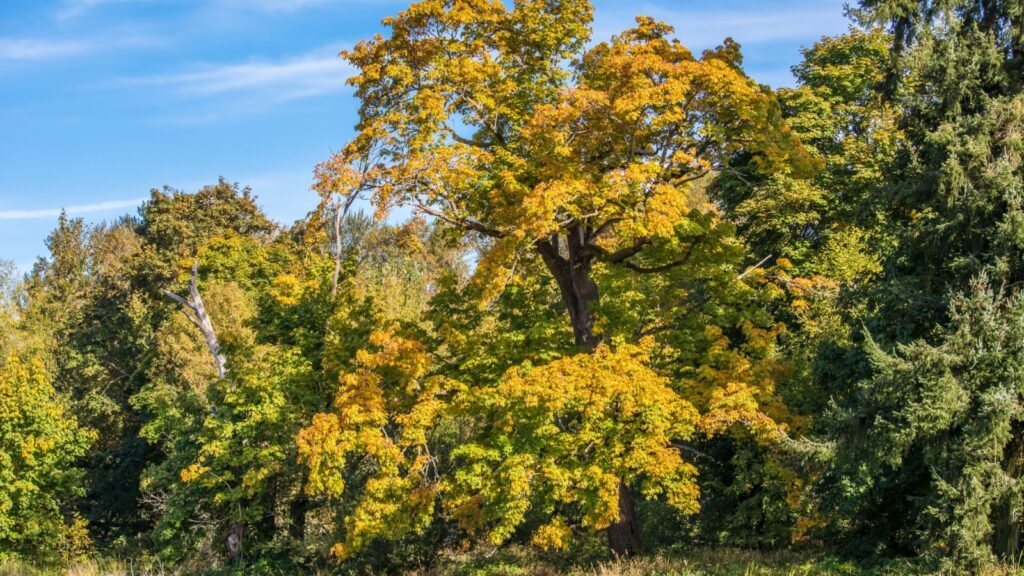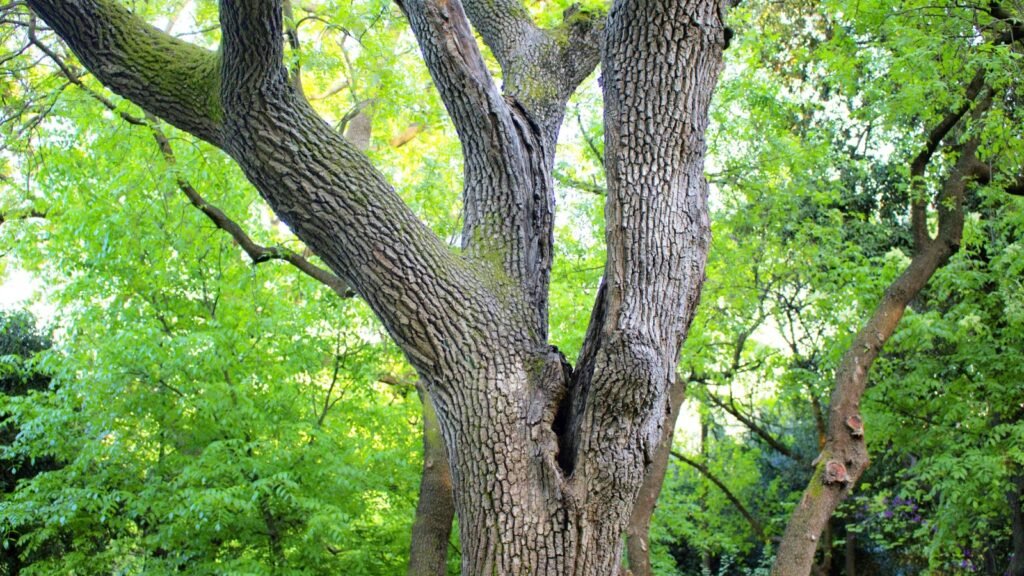Tree tapping has deep roots (pun intended) in history, especially with indigenous tribes who taught early settlers how to tap North America’s maple trees. Over in Europe, Russia, China, and Japan, birch tapping has a long tradition, too. Why? Because tree sap is like nature’s liquid gold. It’s packed with nutrients and can be turned into a sweet treat.
What might surprise you is just how many trees out there are ready for tapping. You might even have one in your own yard!
It’s an incredibly useful skill to have, too, not just for the homestead, but for preppers, too, as syrup from sap provides nutrients and calories for sustenance and a burst of sweetness for morale
Boxelder Maple (Acer negundo)

This fast-growing tree has a bit of a reputation for being messy—its branches are brittle, and it tends to attract boxelder bugs, especially in winter. But if you live near water, you’ve probably seen these trees. While their sap has a lower sugar content, they can still be tapped for syrup. Just know you’ll need about 60 gallons of sap to make a single gallon of syrup. However, if you’ve got a bunch of them, tapping multiple trees can make up for the lower yield per tree.
European Larch (Larix decidua)

This deciduous conifer might not be the first tree you think of for syrup, but its sap can be tapped, too. The syrup it produces is less sweet, with a light, fruity flavor. If you’re in a cooler climate, especially at higher altitudes, the European Larch could be a good alternative to maple. It grows in harsher environments where traditional syrup-producing trees might struggle, giving you more options in less ideal locations.
River Birch (Betula nigra)

This tree loves wet areas, so you’ll often find it along rivers and in floodplains. The River Birch has unique peeling bark in shades of tan to reddish-brown. While its sap has a lower sugar content, it still makes for an interesting syrup with a slightly sweet flavor. Since River Birches are common in swampy areas, they provide an excellent syrup source where maples and other trees may not thrive.
Big Leaf Maple (Acer macrophyllum)

As the name suggests, this West Coast native boasts some huge leaves—sometimes up to a foot wide! Its sap isn’t as high in sugar as the sugar maple, but don’t let that stop you. If you’re in a milder climate, this tree can still give you sap that’s perfect for syrup, as long as the conditions are right. It’s an ideal choice for those living in coastal regions where traditional maple varieties may not flourish.
Grey Birch (Betula populifolia)

This tree looks a lot like the Paper Birch but has bark that doesn’t peel as easily. Grey Birches are more tolerant of a range of temperatures, which means they can grow in much of the U.S., although they only live about 30 years. Still, it’s a great beginner tree for birch tapping. The quick-growing nature of this tree means you can tap them earlier than some other species, giving you sap faster.
Sweet Birch (Betula lenta)

This tree can live a long time if left alone. It’s another great option for tapping, especially since its sap flows quickly in the right conditions. Sweet Birches can live up to 368 years, so tapping them feels like tapping into a piece of history. Its bark has a wintergreen scent that was historically used to make birch beer, adding to its unique character.
Red Maple (Acer rubrum)

If you live in the eastern or central U.S., you’ve probably seen a Red Maple—they’re everywhere. These trees can grow in a wide range of conditions, from swamps to dry ground. While the syrup is just as good as other varieties, the sap season for Red Maples is shorter, making them less common in commercial syrup production. Their versatility in various climates makes them an easy-to-find and easy-to-tap option for the average homesteader.
Ironwood or Hop Hornbeam (Ostrya virginiana)

Ironwood is another lesser-known tree for syrup tapping, but its sap produces a sweet, unique syrup. Found throughout the eastern U.S., this tree has dense wood and a distinctive fruit. The sugar content is lower than maple, so you’ll need more sap, but the flavor makes it worth the effort. Because of its strength and resilience, the Ironwood can withstand harsher tapping methods without damage.
Black Walnut (Juglans nigra)

If you’re lucky enough to have a Black Walnut tree, its sap makes a syrup that’s sweet with a unique nutty flavor. Tapping season is similar to maples, though walnuts tend to bud a little later, giving you more time. While it takes 40 gallons of sap to make one gallon of syrup, the distinct flavor is worth the effort. The wood of the Black Walnut is also valuable, making it a double-purpose tree for both sap and timber.
Alaskan Birch (Betula neoalaskana)

Found mainly in Northern Canada and Alaska, the Alaskan Birch thrives in a range of environments, from mountains to wetlands. It’s a reliable option for sap, much like the Paper Birch, and is often tapped commercially for large-scale syrup production. Its hardiness in cold environments makes it one of the best birches to tap in more extreme northern climates.
Paper Birch (Betula papyrifera)

With its thin, peeling white bark, the Paper Birch is easy to spot. These trees prefer colder climates, and while they don’t live long in warmer areas, they can thrive for over 100 years in cold regions. The Paper Birch has the highest sugar content of any birch, making it one of the best choices for tapping. Its sap also has medicinal properties and has been used in traditional remedies for centuries.
Butternut or White Walnut (Juglans cinerea)

These trees are closely related to the Black Walnut and have a similar sugar content. Unfortunately, Butternuts are becoming endangered, so it’s best to leave them be. If you’re set on tapping a walnut tree, look for its hardier relatives, like the Black Walnut or the hybrid Buartnut. Though tapping Butternuts is discouraged, conservation efforts are underway to protect them from disease, so they may eventually make a comeback.
Canyon Maple (Acer grandidentatum)

Out West, you’ll find the Canyon Maple, a drought-tolerant tree that can grow in all kinds of tough soils, from rocky to sandy. In the right conditions, it produces sap that’s nice and sweet, making it a great option if you live in a dry climate. It’s especially valuable for its ability to thrive in nutrient-poor soils, making it an option for homesteaders in harsher environments.
Sugar Maple (Acer saccharum)

When it comes to syrup, the Sugar Maple is king. Its sap has the highest sugar content, which is why it’s the tree of choice for commercial syrup production. It takes about 40 gallons of sap to make just one gallon of syrup. Sugar Maples also produce a particularly clean sap, with fewer impurities to filter out during syrup production, making the process a bit easier.
Black Maple (Acer nigrum)

Often mistaken for its cousin, the sugar maple, the black maple has three-lobed leaves, unlike the five-lobed sugar maple. With a sugar content on par with the sugar maple, it’s a solid choice for tapping, especially if you live around the Great Lakes region. Black Maples are also more tolerant of shade, making them a great option for mixed forests or partially shaded areas on your land.
Norway Maple (Acer platanoides)

Originally from Europe, the Norway Maple has spread all over North America. Its yellow spring flowers make it easy to spot. While its sap has slightly less sugar than the sugar maple, it still produces a tasty syrup. Norway Maples are often considered invasive, but tapping them can help manage their spread while still putting the tree to good use.
Silver Maple (Acer saccharinum)

Common across the U.S., Silver Maples are fast growers, but they come with some issues—like brittle branches and shallow roots. They can still be tapped for syrup, though the sap is thinner and the sugar content is lower. Since they grow quickly, they’re often used as a fast resource for syrup when you need a large volume of sap quickly.
Yellow Birch (Betula alleghaniensis)

Common in the northeastern U.S. and parts of the Midwest, Yellow Birches are the largest of the birch family and have golden-yellow bark. They grow well in cooler climates, and their sap is rich in antioxidants. Native Americans used the sap and bark for medicinal purposes, adding to its allure for modern tappers. It’s also a favorite for wildlife, so if you’re tapping, be prepared to share a bit with the local animals.
Sycamore (Platanus occidentalis)

The Sycamore is a large shade tree with peeling grey and white bark. While its syrup isn’t as sugary as maple, many say it has a butterscotch or honey-like flavor. If you’ve got one in your yard, give it a try, but be prepared for a bit of mess from falling bark and branches. Despite the lower sugar content, Sycamores are prolific sap producers, making it worth the effort if you have access to multiple trees.
Alder (Alnus genus)

Alders may not have “birch” in the name, but they’re part of the birch family and produce similar sap. These trees are common in the Pacific Northwest, making them a good alternative if maples are hard to come by in your area. The sap makes a syrup with a slightly spicy, unique flavor. Alders also fix nitrogen in the soil, improving the health of surrounding plants and making them a valuable part of any ecosystem where they grow.

